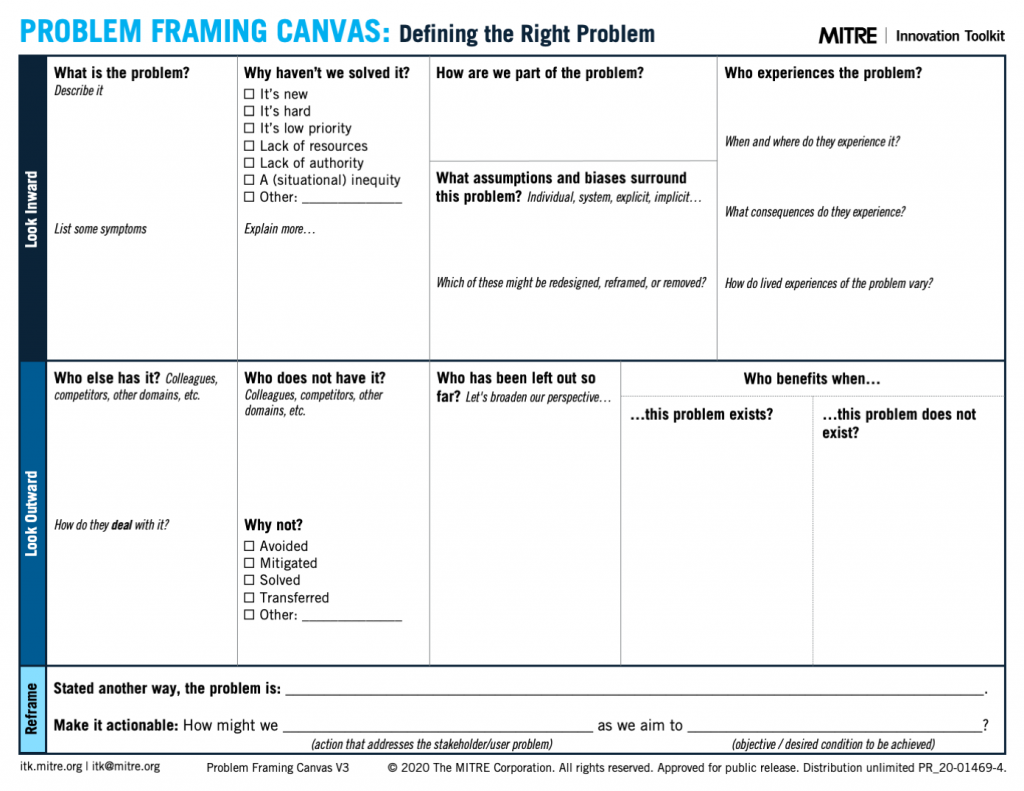Thank you for visiting the Innovation Toolkit
Frame Problem
|Problem Framing
Use the problem framing canvas to explore a problem space and formulate a robust problem statement to ensure you’re solving the right problem.
Session Length: 45+ minutes Group Size: 3+ people Prep Time: 10-20+ minutes
WHEN
Use Problem Framing at the start of the effort, then revisit it periodically to track your progress.
WHY
This approach helps teams:
- Establish consensus about the team’s purpose
- Gain a sense of what “done” will look like
- Define the scope of a team’s initial activities and goals
- Reduce the likelihood of working at cross purposes
HOW
Begin in the upper left corner and capture some words about the problem area. Work through the remaining boxes on the canvas and return to this box throughout the process as your understanding of the problem develops. Answer the questions that are most relevant to your problem area. Feel free to skip any questions that do not seem to apply. Use your inputs to build a problem statement in the bottom box and turn it into an actionable “How might we…” question.
Use the canvas by yourself or in a group. Doing some quick research to collect any necessary information, statistics, or data may be helpful prior to or during the activity.
FACILITATION TIPS
The Problem Framing canvas helps create an inclusive environment, where all members of the team are able to contribute to building a shared understanding of the problem at hand. Facilitators should take care to build a high-trust environment and ensure each participants is encouraged to speak up. This tool helps foster an adaptable mindset among groups, and they often end up coming up with new ways to describe the problem they are working on.
We love this list of 10 Problems With Problem Statements!
Produce an effective problem statement by avoiding problem statements that:
- Assign a cause
- Contain the solution
- Are based on conjecture or belief rather than fact
- Are too long
- Do not describe actual current condition or problem condition
- Do not describe the ideal or desired condition
- Are not measurable
- Are unclear
- Are not specific
- Refer to issues outside of the scope of the actual problem
QUESTION BANK
a.k.a. Additional Questions to help guide the Problem Framing discussion
- What is the scope? How can we expand the scope?
- What are the elements of the problem? (Physical, social, emotional, professional, primary, secondary)
- What prevents/ hinders/ blocks other attempts, or groups, at solving this problem?
- What are we avoiding when looking at or solving this problem?
- What are the stigmas associated with this problem? Is there a stigma we’re trying to avoid?
- What are the concerns or worries others may have about this problem?
- What is unspoken about this problem?
- What language or vocabulary do we not have and need to establish?
- Who denies that this is a problem?
- How does the environment or surrounding “landscape” impact this problem? What historical contexts may be influencing or biasing (our view on) this problem?
- How are we making time to do the work that needs to be done to ensure we are designing equitably?
- Whose perspective or experience isn’t captured yet? Who doesn’t immediately come to mind but also has this problem?
- What types of inequities (uneven distribution or imbalance) exist in this problem? Power, financial, access, etc.
Note: It’s common for teams to iterate through multiple Problem Framing canvases, or that certain sections of this canvas would be complemented by another ITK tool to go more in-depth.
Want a more detailed intro to Problem Framing? Check out this blog post!
Looking for a SIMPLIFIED version?
Problem Framing |Worksheet

Download this tool to print out and start using with your team. Each download includes a tool description and if applicable, a template and example.

